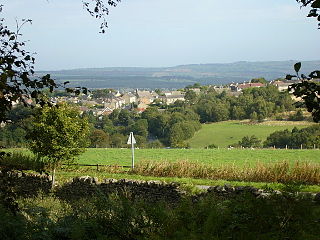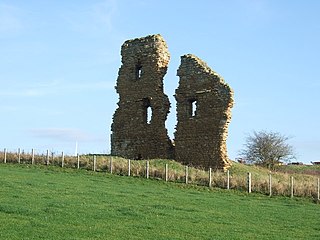Following is a list of dates in the history of Sunderland, the ancient city in North East England. Facts and figures, important dates in Sunderland's history.

Hetton-le-Hole is a town and civil parish in the City of Sunderland, Tyne and Wear, England. It is in the historic county of Durham. A182 runs through the town, between Houghton-le-Spring and Easington Lane, off the A690 and close to the A1(M).

Houghton-le-Spring is a town in the City of Sunderland, Tyne and Wear, North East England which has its recorded origins in Norman times. Historically in County Durham, it is now administered as part of the Tyne and Wear county.

Dalton-le-Dale is a small village in County Durham, in England. The parish population taken at the 2011 census was 1,546. It is situated on the old A19 road between Seaham and Murton. Most of the village is located in a wooded valley bottom, straddling a single road which follows the stream that runs through what is left of Cold Hesledon Dene. Where the road rises to meet the original path of the old A19, there is a small but very fine medieval church which is hidden from the old A19 in a dip. In the opposite direction where the village road to Seaham crosses the stream is Dalden Tower. The pele-tower is the most prominent part of the remains of what was a large medieval manor house complex. The site is a Scheduled Ancient Monument and the tower is Grade II* listed on the National Heritage List for England.

Dipton is a village located in County Durham, England. It is situated to the north-east of Consett, 3 miles south west of Burnopfield and a short distance to the north-west of Annfield Plain.

Castleside is a village in County Durham, England. It is situated a short distance to the south-west of Consett. Castleside is covered by the civil parish of Healeyfield.The village centre is located on the main A68 road which runs between Edinburgh and Darlington and the village crossroads allow easy access to Consett, the North Pennines and Stanhope. To the northeast lie other small villages called Moorside and The Grove.
Edmundbyers is a village in County Durham, in England. It is situated a few miles to the west of Consett, near Derwent Reservoir. In 2001 it had a population of 118. The civil parish of Edmondbyers had a population taken at the 2011 Census of 173. Today, the village has a pub, a youth hostel, a church, a village hall and a small shop. A bus service, the 773, serves the village, connecting it to Townfield, Hunstanworth and Consett.

Whitburn is a village in South Tyneside, in the metropolitan county of Tyne and Wear on the coast of North East England. It is located 3 miles (4.8 km) north of the city of Sunderland and 4 miles (6.4 km) south of the town of South Shields. Historically, Whitburn is part of County Durham. Other nearby population centres include Seaburn, Cleadon and Marsden. The village lies on a south-facing slope, part of Durham's Magnesian Limestone plateau, which overlooks Sunderland. The population for the combined Whitburn and Marsden Ward in the 2011 UK Census was 7,448. For much of its history, Whitburn was a fishing and agricultural community. The village contains three schools, three churches, a cricket club, recreational grounds, a pub and a variety of shops.

Hylton Castle is a stone castle in the North Hylton area of Sunderland, Tyne and Wear, England. Originally built from wood by the Hilton family shortly after the Norman Conquest in 1066, it was later rebuilt in stone in the late 14th to early 15th century. The castle underwent major changes to its interior and exterior in the 18th century and it remained the principal seat of the Hylton family until the death of the last Baron in 1746. It was then Gothicised but neglected until 1812, when it was revitalised by a new owner. Standing empty again until the 1840s, it was briefly used as a school until it was purchased again in 1862. The site passed to a local coal company in the early 20th century and was taken over by the state in 1950.

Lanchester is a village and civil parish in County Durham, England, 8 miles (13 km) west of Durham and 5 miles (8 km) from Consett. It had a population at the 2011 Census of 4,054.

Washington Old Hall is a historic manor house in Washington, Tyne and Wear, England. It lies in the centre of Washington, being surrounded by other villages. The building was the ancestral home of the family of George Washington (1732–1799), the first president of the United States.

The diocese of Durham is a diocese of the Church of England in North East England. The boundaries of the diocese are the historic boundaries of County Durham, meaning it includes the part of Tyne and Wear south of the River Tyne and contemporary County Durham north of the River Tees. It contains 249 parishes and 292 churches. Durham Cathedral is the seat of the bishop of Durham, and the diocesan offices are located just outside the city at Stonebridge. The bishop lives in Bishop Auckland and has offices in Auckland Castle.

Farringdon is a suburb of Sunderland, Tyne and Wear, England. Originally a Monastic grange and manor estate for hundreds of years, Farringdon was rebuilt as a post-war council housing estate in the 1950s. It is approximately 3 mi (4.8 km) south of the city centre along the A690, close to Thorney Close, Silksworth, East Herrington, Gilley Law and Doxford Park. Electorally, the area comes under the St. Chad's ward of the City.

The County Palatine of Durham was a jurisdiction in the North of England, within which the bishop of Durham had rights usually exclusive to the monarch. It developed from the Liberty of Durham, which emerged in the Anglo-Saxon period. The gradual acquisition of powers by the bishops led to Durham being recognised as a palatinate by the late thirteenth century, one of several such counties in England during the Middle Ages. The county palatine had its own government and institutions, which broadly mirrored those of the monarch and included several judicial courts. From the sixteenth century the palatine rights of the bishops were gradually reduced, and were finally abolished in 1836. The last palatine institution to survive was the court of chancery, which was abolished in 1972.
The Ogle family were prominent landed gentry in Northumberland, England. The earliest appearances of the family name were written Hoggel, Oggehill, Ogille and Oghill.

The Tempest family was an English recusant family that originated in western Yorkshire in the 12th century.
Sir Cuthbert Sharp (1781–1849) was an English soldier, official and antiquary.

The Lilburns are a family originating in Northumberland, United Kingdom, and were members of the country's lesser gentry throughout the Late Middle Ages up until the 17th Century. The family name Lilburn derives from the original home of the family, Lilburn, Northumberland.

Ludworth Tower was a manor house and later a pele tower in the pit village of Ludworth, County Durham. Only ruins survive today.
Bryan Abbs (1771–1850) was an English landowner and magistrate for County Durham. He was involved in promoting the construction of the north dock at South Shields, and property development south of the River Tyne.
















